Yamaha A-S2200 operation manual [de]
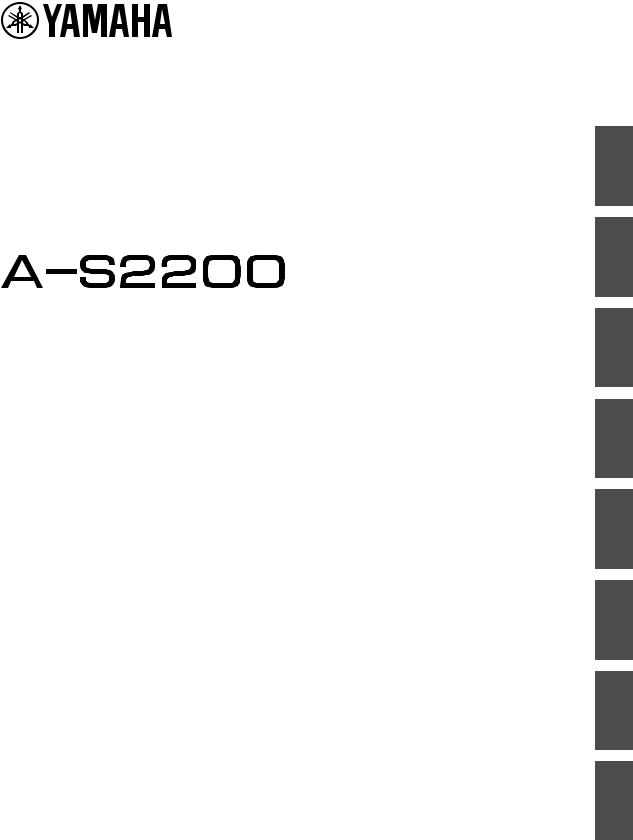
Integrated Amplifier
Amplificateur Intégré Интегрированный усилитель
Owner´s Manual
Mode d´emploi
Benutzerhandbuch
Bruksanvisning
Manuale di istruzioni
Manual de instrucciones Gebruikershandleiding Руководство пользователя
Русский Nederlands Español Italiano Svenska Deutsch Français English

Thank you and congratulations on your purchase of this Yamaha product.
•You can enjoy the high-quality stereo sound of this integrated amplifier at home.
•To use the product properly and safely, we suggest that you read this manual and the “Safety Brochure” thoroughly. Keep the manual in a safe, accessible place for future reference.
English
Features
Floating balanced circuit for power amplifier
Fully-balanced transmission from input to output
Tone control circuit with a parallel volume system
Large power supply with four separate circuits
Left-right symmetrical design
Fully discrete phono amp
Low-impedance, high-performance headphone amp
3

Things to know before using this product
About this manual
•This manual describes the unit’s features and connection procedures.
•The illustrations as shown in this manual are for instructional purposes only.
•Specifications and appearance are subject to change without notice.
• |
“ |
WARNING” describes precautions to be followed to avoid the possibility of serious injury or even death. |
• |
“ |
CAUTION” describes precautions to be followed to avoid injury. |
•“NOTICE” describes precautions to be followed to avoid malfunction or damage to the product.
•“ Note ” describes supplemental information about the product.
Supplied accessories
Please make sure that the following accessories are included in the package.
•Remote control
•Batteries (AAA, R03, UM-4) (×2)
•Power cable*
•Owner’s Manual (this book)
•Safety Brochure
*Multiple power cables might be included in the package depending on the area of distribution. Please use the one that is appropriate for your AC outlet.
Table of Contents
Features. . . . . . . . . . . . . . . . . . . . . . . . . . . . . . . . . 3
Things to know before using this product. . 4
About this manual . . . . . . . . . . . . . . . . . . . . . . . . . . .4 Supplied accessories. . . . . . . . . . . . . . . . . . . . . . . . .4
Part Names and Functions . . . . . . . . . . . . . . . . 5
Front panel. . . . . . . . . . . . . . . . . . . . . . . . . . . . . . . . . .6 Rear panel . . . . . . . . . . . . . . . . . . . . . . . . . . . . . . . . 10 Remote control. . . . . . . . . . . . . . . . . . . . . . . . . . . . 12
Installing batteries in the remote control . . 14 Operating the remote control . . . . . . . . . . . . . 14
Connections . . . . . . . . . . . . . . . . . . . . . . . . . . . . 15
Connection diagram . . . . . . . . . . . . . . . . . . . . . . . 16 Connecting speakers . . . . . . . . . . . . . . . . . . . . . . 18
Using speaker cables . . . . . . . . . . . . . . . . . . . . . 18 Using banana plug cables. . . . . . . . . . . . . . . . . 19 Using Y-shaped lug cables . . . . . . . . . . . . . . . . 19
Bi-wired connection . . . . . . . . . . . . . . . . . . . . . . . .19 Balanced connection . . . . . . . . . . . . . . . . . . . . . . .20 Trigger connection . . . . . . . . . . . . . . . . . . . . . . . . .20 Remote connection. . . . . . . . . . . . . . . . . . . . . . . . .21
Operating the unit from another room. . . . .21 Remote connection between
Yamaha components. . . . . . . . . . . . . . . . . . . . . .21
Connecting the power cable . . . . . . . . . . . . . . . .22
Appendix . . . . . . . . . . . . . . . . . . . . . . . . . . . . . . .23
Specifications . . . . . . . . . . . . . . . . . . . . . . . . . . . . . .24 Block diagram. . . . . . . . . . . . . . . . . . . . . . . . . . . . . .26 Acoustic characteristics . . . . . . . . . . . . . . . . . . . . .27
Tone control characteristics . . . . . . . . . . . . . . .27 Total harmonic distortion . . . . . . . . . . . . . . . . .27 Total harmonic distortion (PHONO) . . . . . . . .28
Troubleshooting . . . . . . . . . . . . . . . . . . . . . . . . . . .29
Maintenance . . . . . . . . . . . . . . . . . . . . . . . . . . . . . . .30
4

English
Part Names and Functions
This section lists the names and describes the function of various parts on the front and rear panels, and the remote control.
5
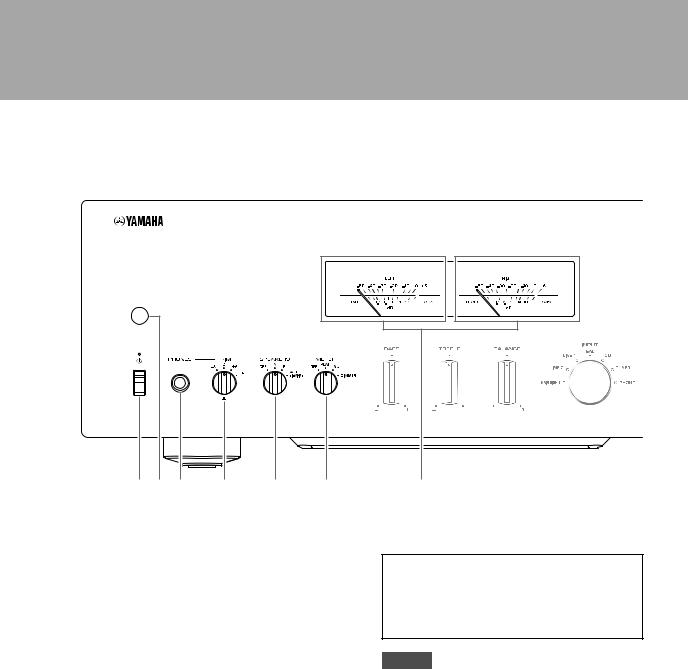
Part Names and Functions
Front panel
1 2 3 |
4 |
5 |
6 |
7 |
1 A(Power) switch/indicator
A(Power) switch |
Power status |
Indicator |
|
|
|
|
|
Up position |
On |
Lit brightly |
|
|
|
||
Standby |
Lit dimly |
||
|
|||
|
|
|
|
Down position |
Off |
Off |
|
|
|
|
While the A (Power) switch is in the up position, press the A AMP key on the remote control repeatedly to switch the power to the unit between on and standby mode. In addition, under either of the following conditions, the unit will enter standby mode.
• If the Auto Power Standby function is enabled. ( page 10)
• If you turn off the power to a device that has been set to trigger connection to this unit. ( page 20)
NOTICE
If you plan not to use the unit for an extended period of time, be sure to unplug the power plug from the AC outlet. Even when the power is turned off, a minimal amount of electric current is still flowing to the unit.
Note
•After you turn on the unit, it will take a few seconds before the unit can reproduce sound.
•Do not turn on the power to this unit again within
10 seconds after the power has been turned off. Doing so may generate noise.
•While the unit is in standby mode, to turn on power to the unit first set the A(Power) switch to the down position to turn the power off, then set the switch to the up position.
•While the unit is in standby mode, if you unplug the power cable from the AC outlet and then plug it in again, the power to the unit will be turned on.
6
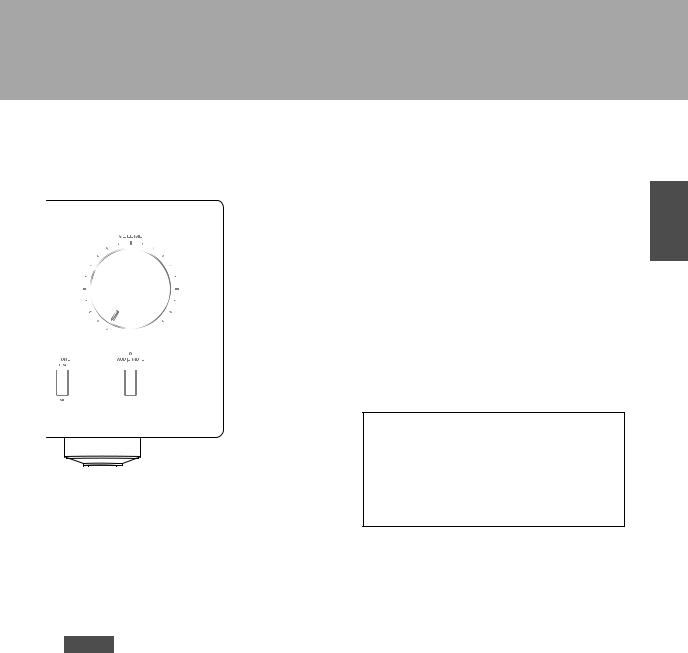
2Remote control sensor
Receives signals from the remote control. ( page 14)
3PHONES jack
Connect your headphones here.
Note
•Connecting the headphones here will result in the following:
-No sound will be heard from the connected speakers.
-Audio signals will not be output at the PRE OUT jacks.
-You will be unable to select MAIN DIRECT as the input source.
•If MAIN DIRECT is selected as the input source, audio signals will not be output at the PHONES jack.
4TRIM selector
Switches the headphone amp gain.
Select the gain setting that is appropriate for your headphones.
Available gain:
−6 dB, 0 dB, +6 dB, +12 dB
5SPEAKERS selector
Switches sets of speakers connected to the SPEAKERS L/R CH A and B terminals on the rear panel as follows:
OFF: No audio signals will be output from the speakers.
A:Audio signals will be output from the set of speakers connected to the A terminals.
B:Audio signals will be output from the set of speakers connected to the B terminals.
A+B BI-WIRING: Audio signals will be output from the sets of speakers connected to the A and B terminals. Select this position when you plan to make a bi-wired connection. ( page 19)
NOTICE
[Model for Asia]
If you connect two sets of speakers (A+B), use the speakers with an impedance of 12Ω or higher.
[Other models]
If you connect two sets of speakers (A+B), use the speakers with an impedance of 8Ω or higher.
6METER selector
Switches the meter function as follows:
OFF: Turns off meter operation and display illumination.
PEAK: Switches the meter display type to a peak level meter. The peak level meter shows the highest instantaneous level of an audio output signal.
VU: Switches the meter display type to a VU (Volume Unit) level meter. The VU level meter shows an effective audio output value that represents the way sound is perceived by human ears.
DIMMER: When selected, the DIMMER automatically changes the brightness of the meter display in steps. When you see the brightness level you desire, switch to another setting parameter to lock in the new brightness setting.
7Meter (LEFT/RIGHT)
Indicates the audio output level of the left (LEFT) and right (RIGHT) channels.
English
7

Part Names and Functions
Front panel
8 9 0 A
8BASS control
Adjusts the volume level of the bass range.
Adjustable range: −10 dB – 0 – +10 dB
9TREBLE control
Adjusts the volume level of the treble range.
Adjustable range: −10 dB – 0 – +10 dB
0BALANCE control
Adjusts the audio output balance between the left and right speakers to compensate for sound imbalances caused by speaker locations or listening room conditions.
Note
•If both BASS and TREBLE controls are set to 0 (zero), the audio signal will bypass the tone control circuit.
•The BASS, TREBLE, and BALANCE control settings will not affect the input signals at the MAIN IN jacks nor the output signals at the LINE 2 OUT jacks.
AINPUT selector/indicator
Selects the input source. The indicator for the selected input source lights up. Audio signals of the selected input source will be output at the LINE 2 OUT jacks.
MAIN DIRECT: Selects the component connected to the MAIN IN jacks as the input source.
LINE 1/LINE 2: Selects the component connected to the LINE 1 or LINE 2 jacks as the input source.
BAL: Selects the component connected to the BAL input jacks as the input source.
CD: Selects the CD player connected to the CD input jacks as the input source.
TUNER: Selects the tuner connected to the TUNER input jacks as the input source.
PHONO: Selects the turntable connected to the PHONO input jacks as the input source.
8
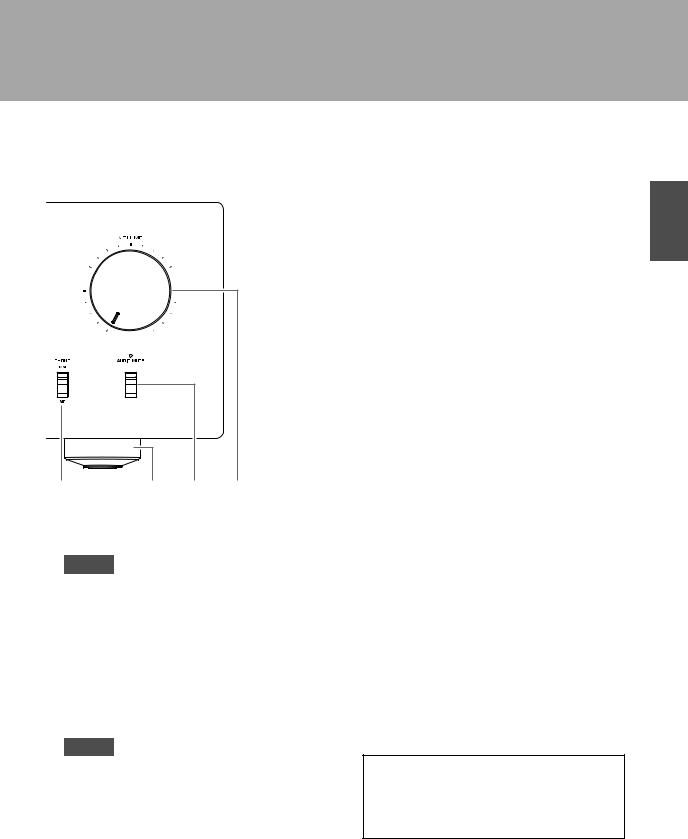
English
B |
C |
D |
E |
Note
•If MAIN DIRECT is selected as the input source, audio signals will not be output at the PRE OUT, LINE 2 OUT or PHONES jacks.
•If LINE 2 is selected, audio signals will not be output at the LINE 2 OUT jacks.
BPHONO switch
Set this switch to the MM or MC position according to the type of magnetic cartridge of the turntable connected to the PHONO input jacks on the rear panel.
Note
Before you replace the cartridge for the turntable, be sure to turn off the power to this unit.
CFeet
If the unit is unstable, adjust the height of the feet as needed by rotating them.
DAUDIO MUTE switch/indicator
Press this switch to reduce the current volume level by approximately 20 dB. The indicator will light up. Press again to restore the audio output to the previous volume level. The indicator will turn off.
EVOLUME knob
Adjusts the volume level. This setting will not affect the output level at the LINE 2 OUT jacks.
NOTICE
If you select MAIN DIRECT as the input source for this unit, the volume level will be fixed. In this case, to adjust the volume level, use the volume control on the external amplifier connected to the MAIN IN jacks.
9

Part Names and Functions
Rear panel
1 |
2 |
7 |
8 |
9 |
0 A |
B |
C |
D |
1 BAL (balanced) input jacks
Note
Set the ATTENUATOR selector and PHASE selector appropriately for the playback component that is connected to these jacks. ( page 20)
2 PRE OUT jacks
Note
•Audio signals output at the PRE OUT jacks are the same channel signals that are output at the SPEAKERS L/R CH terminals.
•The following parameter settings are effective for audio signals output at the PRE OUT jacks.
-BASS
-TREBLE
-BALANCE
-VOLUME
3AUTO POWER STANDBY switch
ON: The unit enters standby mode automatically if it is left turned on and not operated for eight hours (Auto Power Standby function).
OFF: The unit does not enter standby mode automatically.
4TRIGGER IN jack
Connect external components that support the trigger function. ( page 20)
5REMOTE IN/OUT jacks
Connect external components that support the remote function. ( page 21)
6SERVICE jack
This jack is used to test the product.
7SPEAKERS L/R CH terminals
8TUNER input jacks
10
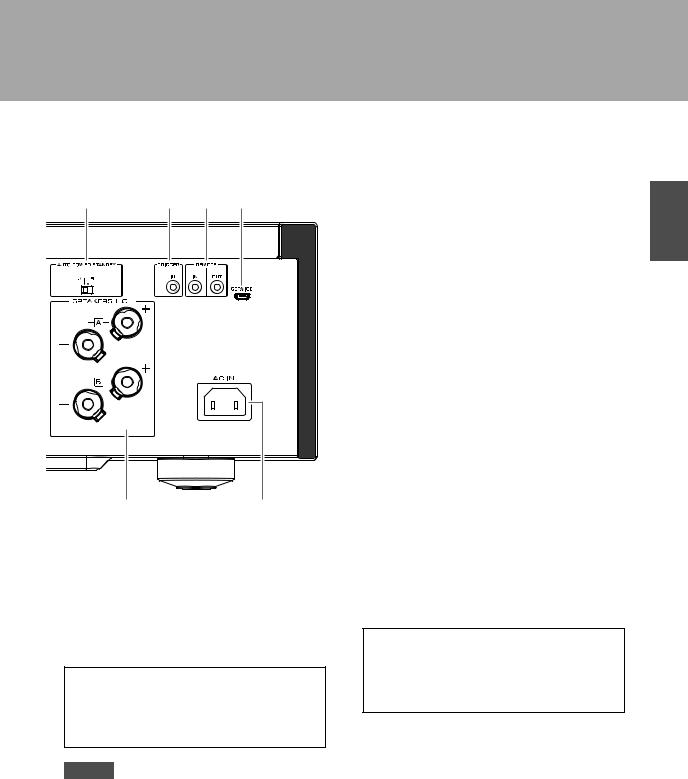
3 4 5 6
English
7 |
E |
9 PHONO input jacks
0 CD input jacks
AGND (Ground) terminal
If you connect your turntable to this unit, ground it to the GND terminal. Doing so may reduce noise.
 CAUTION
CAUTION
Do not loosen the GND terminal knob excessively. Otherwise, the knob may come off and a child may swallow it accidentally.
Note
This is not a safety ground.
BLINE 1 input jacks
CLINE 2 jacks
Connect external components that feature analog audio in/out jacks.
DMAIN IN jacks
Connect external components that feature a volume control function so that you can use this unit as a power amplifier.
NOTICE
If you select MAIN DIRECT as the input source for this unit, the volume level will be fixed. In this case, to adjust the volume level, use the volume control on the external amplifier connected to the MAIN IN jacks.
EAC IN jack
Connect the supplied power cable here. ( page 22)
11
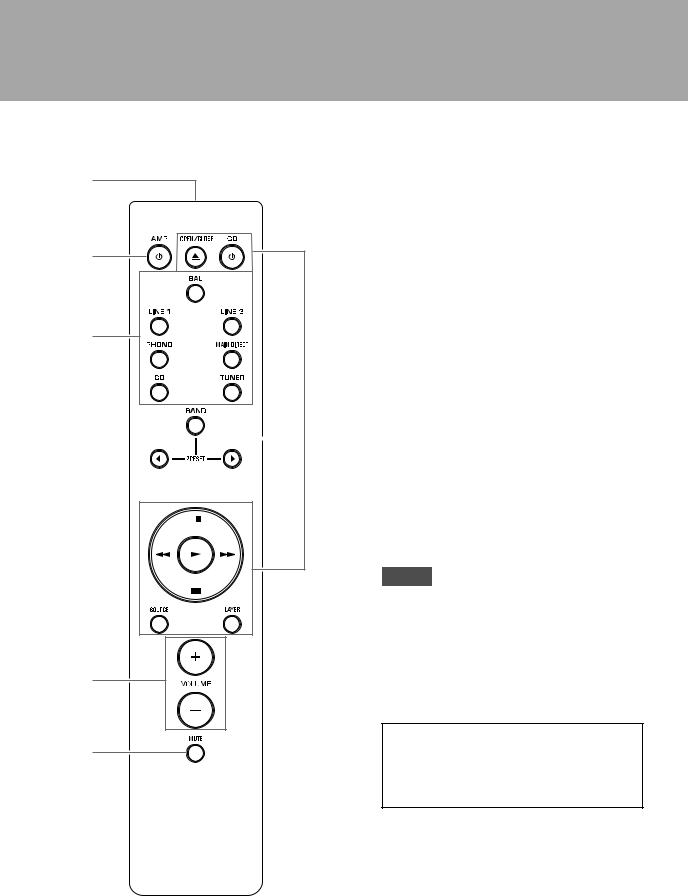
Part Names and Functions
Remote control
1
2
3
4
5
1Infrared signal transmitter
Outputs infrared control signals toward the unit. ( page 14)
2AAMP key
Turns on the power to the unit or switches it to standby mode. ( page 6)
|
|
|
|
|
|
3 Input select keys |
|
|
|
|
|
|
Select the input source. |
|
|
|
|
|
|
Audio signals of the selected input source will be |
|
|
|
|
|
|
output at the LINE 2 OUT jacks. |
|
|
|
|
|
|
BAL: Selects the component connected to the BAL |
|
|
|
|
|
|
input jacks as the input source. |
|
|
|
|
|
|
LINE 1/LINE 2: Selects the component connected to |
|
|
|
|
|
|
the LINE 1 or LINE 2 jacks as the input source. |
|
|
|
|
|
|
PHONO: Selects the turntable connected to the |
|
|
|
6 |
|
|
PHONO input jacks as the input source. |
|
|
|
|
|||
|
|
|
|
|
|
MAIN DIRECT: Selects the component connected to |
|
|
|
|
|
7 |
the MAIN IN jacks as the input source. |
|
|
|
|
|
||
|
|
|
|
|
CD: Selects the CD player connected to the CD input |
|
|
|
|
|
|
|
|
|
|
|
|
|
|
jacks as the input source. |
|
|
|
|
|
|
|
|
|
|
|
|
|
TUNER: Selects the tuner connected to the TUNER |
|
|
|
|
|
|
input jacks as the input source. |
Note
•If MAIN DIRECT is selected as the input source, audio signals will not be output at the PRE OUT, LINE 2 OUT or
PHONES jacks.
• If LINE 2 is selected, audio signals will not be output at the LINE 2 OUT jacks.
4 VOLUME +/− keys
Adjust the volume level. This setting will not affect the output level at the LINE 2 OUT jacks.
NOTICE
If you select MAIN DIRECT as the input source for this unit, the volume level will be fixed. In this case, to adjust the volume level, use the volume control on the external amplifier connected to the MAIN IN jacks.
5MUTE key
Press this key to reduce the current volume level by approximately 20 dB. Press the key again to restore the previous volume level.
12

6Tuner control keys
Control the functions of a connected Yamaha tuner. For more information, refer to the owner’s manual for your tuner.
7CD player control keys
Control the functions of a connected Yamaha CD player. For more information, refer to the owner’s manual for your CD player.
 OPEN/CLOSE key: Opens or closes the disc tray of a connected CD player.
OPEN/CLOSE key: Opens or closes the disc tray of a connected CD player.
A CD key: Turns on the power to a connected CD player, or switches it to standby mode.
 (Play): Starts playback of the CD player.
(Play): Starts playback of the CD player.

 (Pause): Pauses playback of the CD player. Press
(Pause): Pauses playback of the CD player. Press  or
or 
 to resume playback.
to resume playback.
 (Stop): Stops playback of the CD player.
(Stop): Stops playback of the CD player.
 /
/  (Skip): Skips to the next track, or returns to the beginning of the current track.
(Skip): Skips to the next track, or returns to the beginning of the current track.
SOURCE key: Selects the source to be played on the CD player. The playback source changes each time this key is pressed.
LAYER key: Toggles the playback layer of a hybrid super audio CD between “Super audio CD” and “CD.”
Note
Some Yamaha tuners or CD players might not support the tuner or CD player control keys.
English
13
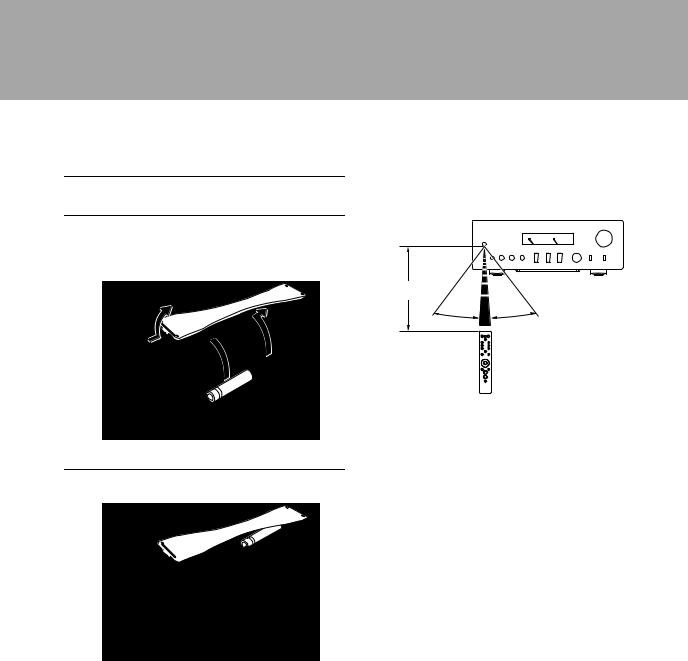
Part Names and Functions
■Installing batteries in the remote control
1Remove the battery compartment cover.
2Insert two batteries (AAA, R03, UM-4) according to the polarity markings (+ and −) on the inside of the battery compartment.
1

 2
2 

3 Reinstall the battery compartment cover.
3


■ Operating the remote control
Operate the remote control in the range shown below by pointing it toward the remote control sensor on the front panel of the unit.
Within 6 m
30
 30
30
14

English
Connections
This section explains how to connect the unit to speakers and audio source components.
15
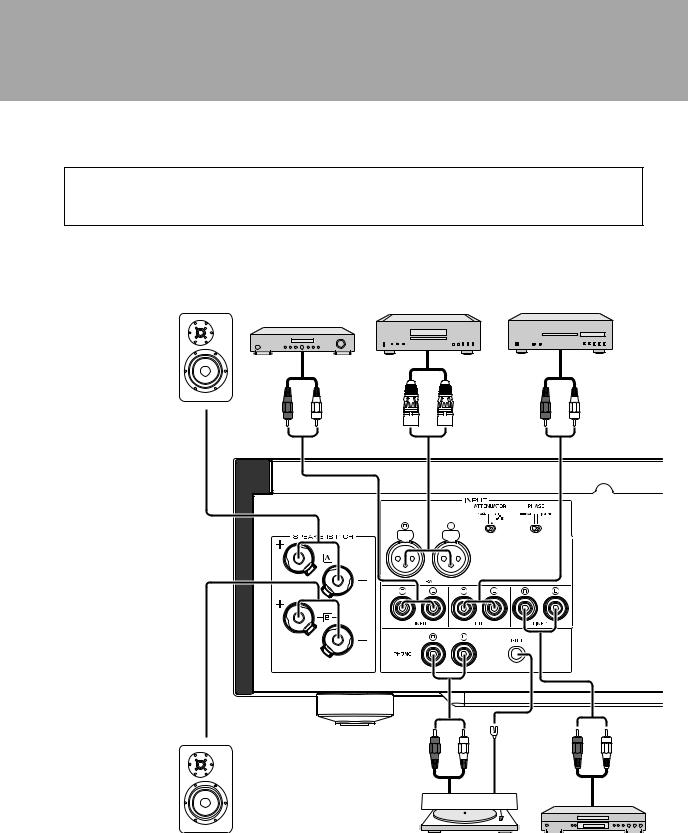
Connections
Connection diagram
 CAUTION
CAUTION
Be sure to complete all connections before plugging in the power cable to an AC outlet. ( page 22)
CD player or network |
CD player featuring |
player featuring XLR jacks |
|
( page 20) |
RCA jacks |
Speaker A |
Tuner |
(R channel) |
|
( page 18) |
|
+ -
-
+ -
-
Speaker B (R channel) ( page 18)
Turntable |
BD player, etc. |
16
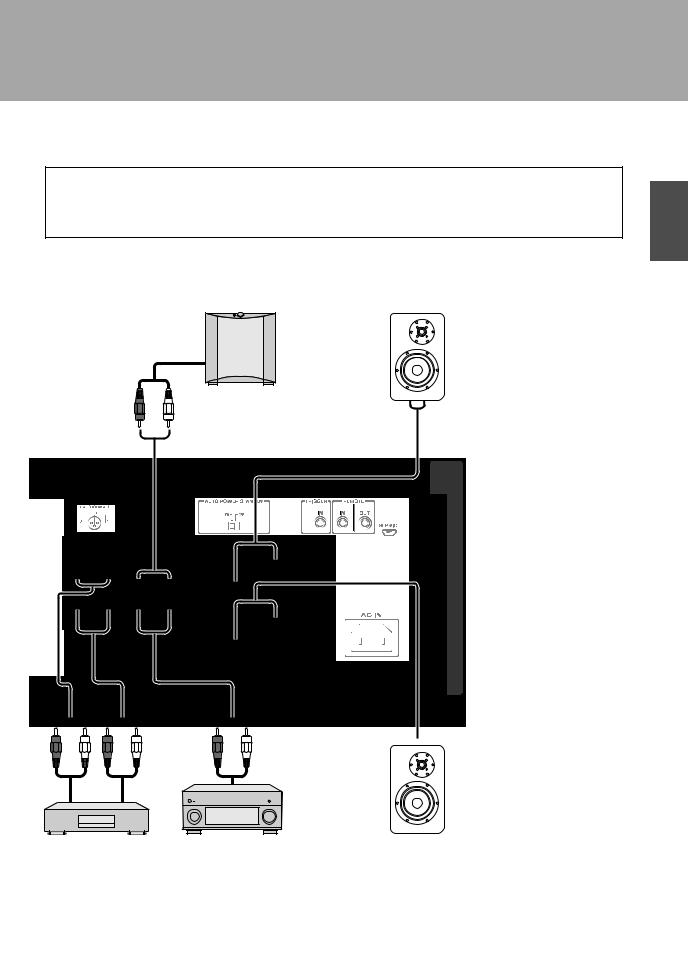
NOTICE
If a component is connected to the MAIN IN jacks, the unit’s volume level will be fixed. Therefore, do not connect a CD player or other components that do not feature volume adjustment to the MAIN IN jacks. Otherwise, a loud sound may be emitted, resulting in malfunction of the unit or damage to the speakers.
External amplifier or active subwoofer
Speaker A (L channel)
- |
+ |
– +
+
Speaker B (L channel)
CD recorder, tape deck, |
Preamplifier, |
etc. |
AV amplifier, etc. |
English
17
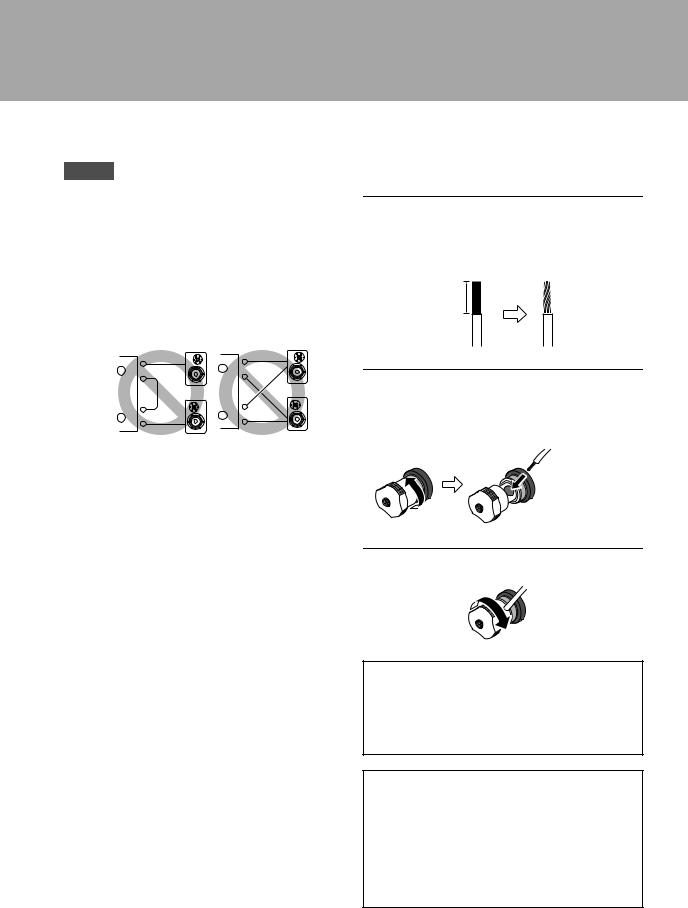
Connections
Note
•Because this power amplifier is of the floating balanced type, the following connections are not possible.
-Connecting between two “+” (or two “−”) terminals of the left and right channels (Fig. 1).
-Connecting each “−” terminal of the unit’s left and right channels to the opposite channel speakers (cross connection, Fig. 2).
-Connecting the left/right channel “−” terminals (or accidentally allowing them to come in contact) with the metal part of the rear panel of this unit.
Figure 1 |
Figure 2 |
|
+ |
+ |
|
L |
||
L |
||
– |
||
– |
||
|
||
– |
– |
|
R |
||
R |
||
+ |
||
+ |
||
|
• Do not connect an active subwoofer to the SPEAKERS L/R CH terminals. Connect the subwoofer to the unit’s PRE OUT jacks.
Connecting speakers
■ Using speaker cables
1Remove approximately 10 mm of insulation from the end of each speaker cable, and twist the exposed wires together tightly to prevent short circuits.
10 mm
2Unscrew the knob on each speaker terminal, and then insert the bare wire into the side hole on the terminal.
Diameter of the speaker cable wire hole: 6.0 mm
3 Tighten the knob.
 CAUTION
CAUTION
•Do not loosen the knob excessively. Otherwise, the knob may come off and a child may swallow it accidentally.
•To reduce the risk of electric shock, do not touch the speaker terminals while the power to the unit on.
NOTICE
•If the SPEAKERS terminals come into contact with a metallic rack, a short circuit may occur, resulting in damage to this unit. When installing the unit in a rack, maintain a sufficient clearance to prevent the SPEAKERS terminals from coming into contact with the rack.
•Do not let the bare speaker wires touch each other, nor let them touch any metal part of this unit. Otherwise, the unit and/or the speakers may be damaged.
18
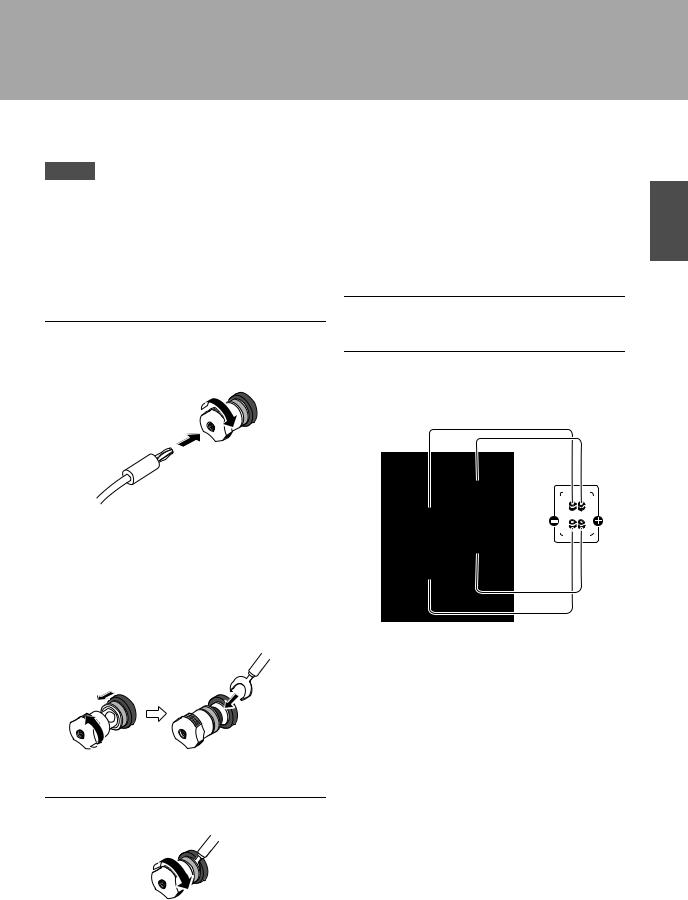
Note
All connections must be correct: L (left) to L, R (right) to R, “+” to “+”, and “−” to “−”. For information regarding the connection procedure, refer to the owner’s manual for your speakers.
■ Using banana plug cables
(Models for U.S.A., Canada, Australia, China, and Taiwan)
First tighten the knob on the SPEAKERS terminal, and then insert the banana plug into the head of the knob.
Bi-wired connection
A bi-wired connection separates the woofer from the mid and high ranges. Speakers that support bi-wired connection feature two pairs of terminals (total four terminals). These two pairs of terminals can divide the speakers into two independent parts. To make this kind of connection, you need to connect mid and high range drivers to one pair of terminals, and low range drivers to the other pair of terminals.
1Remove the shorting bars or bridges on the speakers.
2Connect this unit to the speakers as shown in the figure below.
An example of left channel connection
Banana plug
Diameter of the
banana plug hole: 4.0 mm
■ Using Y-shaped lug cables
1Unscrew the knob, and then sandwich the Y-shaped lug between the ring part and
base of the terminal. |
Rear panel of this unit |
Speaker |
Y-shaped lug |
3 Set the SPEAKERS selector on the front |
|
|
panel to A+B BI-WIRING. |
|
Thickness of the terminal core: 5.8 mm
2 Tighten the knob.
English
19

Connections
Balanced connection |
Trigger connection |
You can connect a CD player or network player that features XLR-type balanced output jacks to the BAL input jacks of this unit. Use XLR-type balanced cables for this connection.
ATTENUATOR selector: Enables you to set the allowable input level at the balanced input jacks. Select ATT. (−6 dB) if the audio output from the connected component sounds distorted.
PHASE selector: Enables you to set the position (phase) of the HOT pin (pin #2: HOT or pin #3: HOT) at the balanced input jacks.
NORMAL (Pin #2: HOT)
2: HOT (+) |
1: GND (earth) |
|
3: COLD (−) |
INV.
(Pin #3: HOT)
2: COLD (−) |
1: GND (earth) |
|
3: HOT (+) |
Refer to the instruction manual for the connected component to find out the position of the HOT pin at the balanced output jacks on the component.
Note
•Select NORMAL (pin #2 is HOT) for a Yamaha player.
•Do not use balanced and unbalanced connections for one component simultaneously. Doing so would create a ground loop that could generate static and noise.
•When connecting a cable, be sure to align the pins on the connector with the holes on the jack, and then insert the male XLR connector into the jack until you hear a click. To remove the cable, while pressing and holding down the lever on the BAL input jack, pull out the male XLR connector from the jack.
XLR connector |
Lever |
(female) |
|
You can connect a Yamaha AV receiver or other component that supports the Trigger function. You can control this unit in sync with a connected component.
Rear panel of this unit
|
TRIGGER |
MAIN IN |
IN |
|
Stereo pin cable |
|
|
|
|
Monaural |
|||
|
||||||||
|
|
|
|
mini-plug cable |
||||
|
|
|
|
|
|
|
|
|
|
|
|
|
|
|
|
|
|
|
|
|
|
|
|
|
|
|
|
|
|
|
|
|
|
|
|
|
|
|
|
|
|
|
|
|
PRE OUT
TRIGGER
OUT |
Yamaha AV receiver or other component that features
TRIGGER OUT jacks and PRE OUT jacks
When the power to the connected component is turned on, the power to this unit is also turned on. Simultaneously, the input source to the unit is set to MAIN DIRECT.
If MAIN DIRECT has been selected as the input source for this unit, when the power to the connected component is turned off, this unit will enter standby mode.
Note
When the power switch on this unit is turned Off, the power to the unit will not be triggered.
XLR connector |
BAL input jack |
(male) |
|
• For a balanced connection, select BAL as the input source.
20
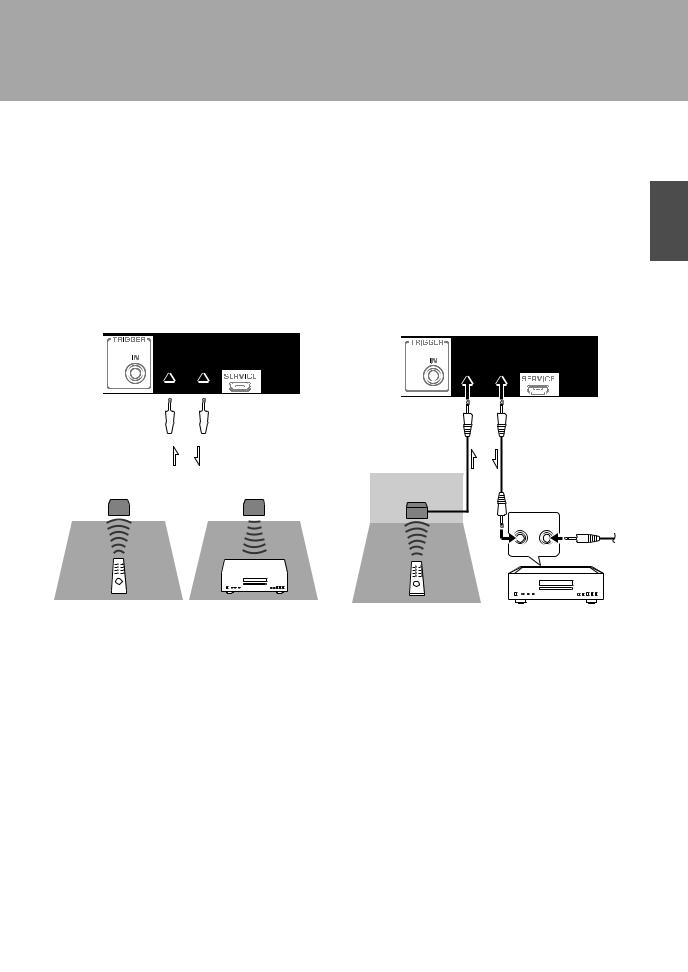
Remote connection
■ Operating the unit from another room
If you connect a commercially-available infrared receiver and transmitter to the unit’s REMOTE IN/OUT jacks, you will be able to operate the unit and/or external component from another room, using the supplied remote control.
Rear panel of this unit
Infrared receiver |
|
Infrared |
|
transmitter |
|
|
|
|
|
|
|
Remote control |
External component |
|
(CD player, etc.) |
■Remote connection between Yamaha components
If you have another Yamaha component that supports remote connections, an infrared transmitter is not necessary. Connect an infrared receiver to the unit’s REMOTE IN/OUT jacks, as shown below.
Up to 3 Yamaha components (including this unit) can be set up for remote connection.
Rear panel of this unit
Monaural mini-plug cable
Infrared receiver
REMOTE
IN OUT
Remote control |
Yamaha component |
|
(up to 3 components, |
|
including this unit) |
English
21

Connections
Connecting the power cable
After all connections are complete, plug the power cable into the AC IN connector of the unit, and then plug the power plug into the AC outlet.
Rear panel of this unit
Supplied power cable
To outlet
22

English
Appendix
This section lists technical specifications for this unit.
23

Appendix
Specifications
Rated output power (20 Hz to 20 kHz, 0.07% THD) 2-channel driven
[Model for Asia] |
|
8Ω............................................................ |
90 W + 90 W |
6Ω......................................................... |
110 W + 110 W |
[Other models] |
|
8Ω............................................................ |
90 W + 90 W |
4Ω........................................................ |
150 W + 150 W |
Dynamic power |
|
8Ω........................................................ |
105 W + 105 W |
6Ω........................................................ |
135 W + 135 W |
4Ω........................................................ |
190 W + 190 W |
2Ω........................................................ |
220 W + 220 W |
IEC output power (1 kHz, 0.07% THD)
[Models for U.K. and Europe] |
|
8Ω............................................................ |
95 W + 95 W |
Maximum effective output power |
|
(JEITA, 1 kHz, 10% THD) |
|
8Ω........................................................ |
120 W + 120 W |
4Ω........................................................ |
190 W + 190 W |
Power bandwidth (0.1% THD, 45 W) |
|
2-channel driven |
|
8Ω........................................................ |
10 Hz to 50 kHz |
Damping factor (1 kHz) |
|
8Ω............................................................. |
250 or higher |
Input sensitivity / input impedance (1 kHz, 100 W/8Ω)
PHONO (MC) ................................... |
150 μVrms / 50Ω |
PHONO (MM) ............................... |
3.5 mVrms / 47 kΩ |
CD (or similar) .............................. |
200 mVrms / 47 kΩ |
MAIN IN ............................................... |
1 Vrms / 47 kΩ |
BAL ............................................. |
200 mVrms / 100 kΩ |
Maximum input / signal voltage (1 kHz, 0.5% THD)
PHONO (MC).............................................. |
|
2.0 mVrms |
PHONO (MM).............................................. |
|
50 mVrms |
CD (or similar).............................................. |
|
2.80 Vrms |
BAL |
|
|
BYPASS..................................................... |
|
2.80 Vrms |
ATT. (−6 dB).............................................. |
|
5.60 Vrms |
Rated output voltage / output impedance |
|
|
LINE 2 OUT ................................. |
200 mVrms / 1.5 kΩ |
|
PRE OUT............................................. |
1 Vrms / 1.5 kΩ |
|
Headphone jack rated output power |
|
|
(1 kHz, 32Ω, 0.2% THD) |
|
|
........................................................... |
50 mW + 50 mW |
|
Frequency response |
|
|
5 Hz to 100 kHz............................................ |
|
+0 / −3 dB |
20 Hz to 20 kHz......................................... |
+0 / −0.3 dB |
|
Deviations from RIAA equalizer |
|
|
PHONO (MM/MC) .......................................... |
|
±0.5 dB |
Total harmonic distortion plus noise |
|
|
(JEITA, input 0.5 V, 20 Hz to 20 kHz) |
|
|
2-channel driven |
|
|
PHONO (MC) → LINE 2 OUT, 1.2 Vrms .......... |
0.02% |
|
PHONO (MM) → LINE 2 OUT, 1.2 Vrms ....... |
0.005% |
|
CD (or similar)/BAL → |
|
|
SPEAKERS OUT, 50 W/8Ω.............................. |
|
0.035% |
Signal-to-noise ratio (JEITA, IHF-A network) |
|
|
PHONO (MC)...................................................... |
|
90 dB |
PHONO (MM)..................................................... |
|
96 dB |
CD (or similar)................................................... |
|
110 dB |
BAL ................................................................... |
|
114 dB |
Residual noise (IHF-A network)
....................................................................... 33 μVrms
24

Channel separation (JEITA, 1 kHz/10 kHz)
PHONO (MC).................................. |
|
66/77 dB or higher |
PHONO (MM)................................. |
|
90/77 dB or higher |
CD (or similar)/BAL........................ |
|
74/54 dB or higher |
Tone control characteristics |
|
|
BASS |
|
|
Boost/cut ................................................. |
|
50 Hz / ±9 dB |
Turnover frequency............................................ |
|
350 Hz |
TREBLE |
|
|
Boost/cut ............................................... |
|
20 kHz / ±9 dB |
Turnover frequency........................................... |
|
3.5 kHz |
Power supply |
|
|
[Models for U.S.A. and Canada] |
....... AC 120 V, 60 Hz |
|
[Model for China] .............................. |
|
AC 220 V, 50 Hz |
[Model for Korea].............................. |
|
AC 220 V, 60 Hz |
[Model for Australia]......................... |
|
AC 240 V, 50 Hz |
[Models for U.K. and Europe]........... |
AC 230 V, 50 Hz |
|
[Model for Asia] .............. |
AC 220–240 V, 50 Hz/60 Hz |
|
[Model for Taiwan]............................. |
|
AC 110 V, 60 Hz |
Power consumption |
|
|
[Model for Asia] ................................................. |
|
250 W |
[Other models] .................................................... |
|
350 W |
Standby power consumption |
|
|
OFF mode ............................................................ |
|
0.1 W |
Standby mode ...................................................... |
|
0.2 W |
Maximum power consumption (1 kHz, 4Ω 10% THD)
[Model for Taiwan]............................................. |
700 W |
Dimensions (W × H × D)
..................................................... 435 × 157 × 463 mm
Weight
........................................................................... 22.7 kg
*The contents of this manual apply to the latest specifications as of the publishing date. To obtain the latest manual, access the Yamaha website and download the manual file.
English
25
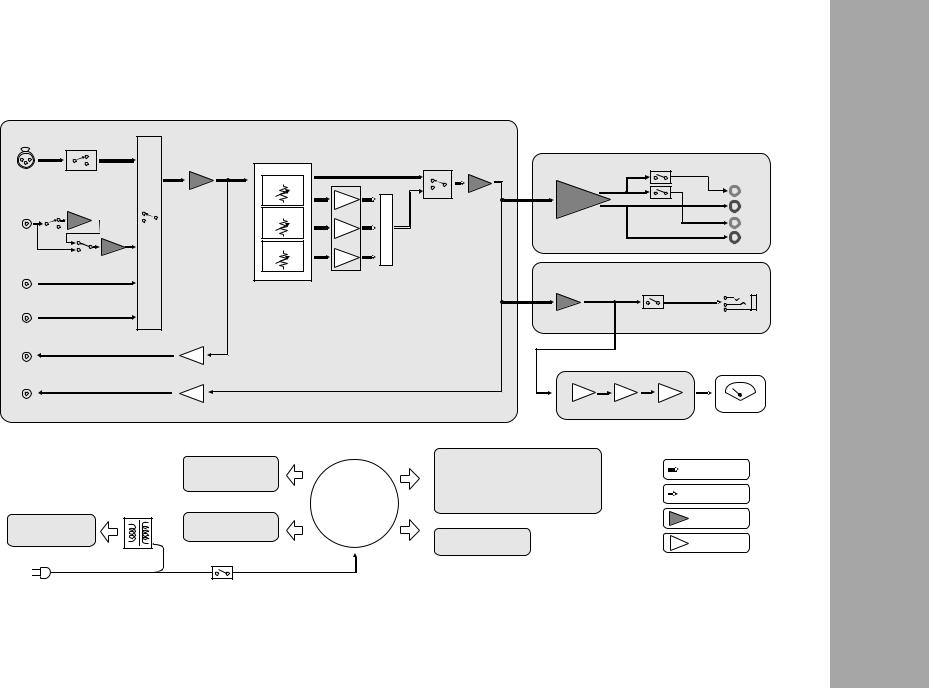
26
BAL
PHONO
CD / TUNER LINE1 / LINE2
MAIN IN
LINE2 OUT
PREOUT
INPUT SELECTOR
PHASE CHANGE (normal/inv.)
VOLUME
LINE AMP
TREBLE
MC HEAD AMP
MIDDLE
BASS
MM EQ AMP
LINE2 OUT AMP
PREOUT AMP
CONSTANT CURRENT
POWER SUPPLY
FOR AUDIO
SUB TRANSFORMER
POWER SUPPLY |
POWER SUPPLY |
|
FOR CONTROL |
||
FOR CPU |
||
|
TONE CONTROL BYPASS
CONTROL TONE
TONE CONTROL
TOROIDAL
TRANSFORMER
LINE AMP |
FLOATING BALANCE |
SPEAKER A/B |
SPEAKER OUT
POSITIVE OUT
+
A
−
NEGATIVE OUT
+
B
−
LOW IMPEDANCE DRIVE
HEADPHONE
METER DRIVER
|
|
|
RECTIFICATION |
LOG AMP |
DRIVER |
METER |
|
|
|
|
PEAK/VU |
|
|
|
|
FLOATING INDEPENDENT |
|
|
|
||||
POWER SUPPLY |
|
|
|
|
BALANCE SIGNAL |
||
|
|
|
|
|
|
|
|
L ch + |
|
|
R ch + |
|
|
|
|
|
|
|
|
|
|
|
|
L ch − |
|
|
R ch − |
|
|
|
UNBALANCE SIGNAL |
|
DISCRETE AMP |
|
POWER AMP PRE STAGE |
OPE AMP |
|
POWER SUPPLY |
||
|
diagram Block |
Appendix |
POWER RELAY
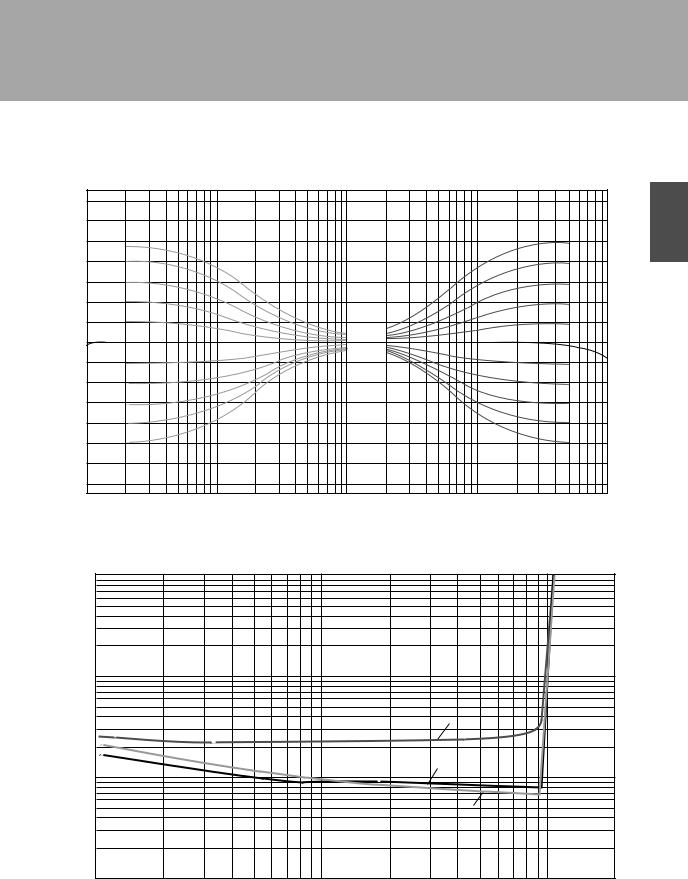
Acoustic characteristics
■ Tone control characteristics
|
14 |
|
12 |
|
10 |
|
8 |
|
6 |
(dB) |
4 |
2 |
|
Response |
0 |
|
|
|
–2 |
|
–4 |
|
–6 |
|
–8 |
|
–10 |
|
–12 |
|
–14 |
|
10 |
20 |
30 |
50 |
100 |
200 |
300 |
500 |
1k |
2k |
3k |
5k |
10k |
20k |
30k |
50k |
100k |
|
|
|
|
|
|
|
|
|
Frequency (Hz) |
|
|
|
|
|
|
|
|
■ Total harmonic distortion |
|
|
|
|
|
|
|
|
|
|
|
|
|||||
|
1.000 |
|
|
|
|
|
|
|
|
|
|
|
|
|
|
|
|
|
0.500 |
|
|
|
|
|
|
|
|
|
|
|
|
|
|
|
|
|
0.200 |
|
|
|
|
|
|
|
|
|
|
|
|
|
|
|
|
|
0.100 |
|
|
|
|
|
|
|
|
|
|
|
|
|
|
|
|
(%) |
0.050 |
|
|
|
|
|
|
|
|
|
|
|
|
|
|
|
|
+ N Ratio |
|
|
|
|
|
|
|
|
|
|
|
|
|
|
|
|
|
|
|
|
|
|
|
|
|
|
|
|
|
20kHz |
|
|
|
|
|
0.020 |
|
|
|
|
|
|
|
|
|
|
|
|
|
|
|
|
|
THD |
|
|
|
|
|
|
|
|
|
|
|
|
|
|
|
|
|
|
|
|
|
|
|
|
|
|
|
|
20Hz |
|
|
|
|
||
0.010 |
|
|
|
|
|
|
|
|
|
|
|
|
|
|
|
|
|
|
|
|
|
|
|
|
|
|
|
|
|
|
|
|
|
|
|
|
0.005 |
|
|
|
|
|
|
|
|
|
|
|
1kHz |
|
|
|
|
|
|
|
|
|
|
|
|
|
|
|
|
|
|
|
|
|
|
|
0.002 |
|
|
|
|
|
|
|
|
|
|
|
|
|
|
|
|
|
0.001 |
|
|
|
|
|
|
|
|
|
|
|
|
|
|
|
|
|
1 |
|
|
2 |
|
5 |
|
|
10 |
20 |
|
|
50 |
|
100 |
|
|
Output (W)
English
27

Appendix
■ Total harmonic distortion (PHONO)
|
10 |
|
|
|
|
|
|
|
|
|
|
|
|
|
|
5 |
|
|
|
|
|
|
|
|
|
|
|
|
|
|
3 |
|
|
|
|
|
|
|
|
|
|
|
|
|
|
2 |
|
|
|
|
|
|
|
|
|
|
|
|
|
|
1 |
|
|
|
|
|
|
|
|
|
|
|
|
|
|
0.5 |
|
|
|
|
|
|
|
|
|
|
|
|
|
(%) |
0.3 |
|
|
|
|
|
|
|
|
|
|
|
|
|
0.2 |
|
|
|
|
|
|
|
|
|
|
|
|
|
|
0.1 |
|
|
|
|
|
|
|
|
|
|
|
|
|
|
Ratio |
|
|
|
|
|
|
|
|
|
|
|
|
|
|
0.05 |
|
|
|
|
|
|
|
|
|
|
|
|
|
|
N |
0.03 |
|
20Hz |
|
1kHz |
|
|
|
20kHz |
|
|
|
|
|
+ |
|
|
|
|
|
|
|
|
|
|
|
|
|
|
0.02 |
|
|
|
|
|
|
|
|
|
|
|
|
|
|
THD |
|
|
|
|
|
|
|
|
|
|
|
|
|
|
0.01 |
|
|
|
|
|
|
|
|
|
|
|
|
|
|
|
0.005 |
|
|
|
|
|
|
|
|
|
|
|
|
|
|
0.003 |
|
|
|
|
|
|
|
|
|
|
|
|
|
|
0.002 |
|
|
|
|
|
|
|
|
|
|
|
|
|
|
0.001 |
|
|
|
|
|
|
|
|
|
|
|
|
|
|
0.0005 |
|
|
|
|
|
|
|
|
|
|
|
|
|
|
0.0003 |
|
|
|
|
|
|
|
|
|
|
|
|
|
|
0.0002 |
|
|
|
|
|
|
|
|
|
|
|
|
|
|
0.0001 |
|
|
|
|
|
|
|
|
|
|
|
|
|
|
100µ |
200µ |
500µ |
1m |
2m |
5m |
10m |
20m |
50m |
100m |
200m |
500m |
1 |
2 |
Generator Level (Vrms)
28

Troubleshooting
Refer to the table below if this unit does not function properly. If the instructions below do not help, or if the problem you are experiencing is not listed below, turn off the unit, disconnect the power plug, and contact the nearest authorized Yamaha dealer or service center.
Problem |
Cause |
Remedy |
See |
|
page |
||||
|
|
|
||
|
|
|
|
|
|
The power cable is not connected to |
|
|
|
|
the AC IN connector on the rear panel |
Connect the power cable firmly. |
22 |
|
Power does not turn on. |
or is not plugged into an AC outlet. |
|
|
|
|
|
|
||
The unit has been exposed to a |
Turn off the unit, disconnect the power plug from |
|
||
|
|
|||
|
strong external electric shock (such as |
the AC outlet, wait for about 30 seconds, and then |
— |
|
|
lightning or strong static electricity). |
plug the unit in again. |
|
|
|
|
|
|
|
|
The protection circuitry has been |
Make sure that the speaker wires are not touching |
|
|
The A(Power) indicator |
activated because of a short circuit, |
each other or shorting out against the rear panel of |
18 |
|
etc. |
the unit, and then turn on the power to the unit. |
|
||
on the front panel |
|
|
|
|
|
Disconnect the power plug from the AC outlet and |
|
||
flashes. |
There is a problem with the internal |
— |
||
|
contact the nearest authorized Yamaha dealer or |
|||
|
circuitries of this unit. |
|||
|
service. |
|
||
|
|
|
||
|
|
|
|
|
When the unit is |
|
|
|
|
powered on, the INPUT |
The protection circuitry has been |
Make sure that the speaker wires are not touching |
|
|
indicator flashes and |
activated because of a short circuit, |
each other or shorting out against the rear panel of |
18 |
|
the volume level |
etc. |
the unit, and then turn on the power to the unit. |
|
|
decreases. |
|
|
|
|
|
|
|
|
|
|
Incorrect input or output cable |
Connect the cables properly. If the problem |
16 |
|
|
connections. |
persists, the cables might be defective. |
||
|
|
|||
|
|
|
|
|
|
No appropriate input source has been |
Select an appropriate input source using the INPUT |
|
|
|
selector on the front panel (or one of the input |
8, 12 |
||
|
selected. |
|||
No sound is heard. |
selector keys on the remote control). |
|
||
|
|
|||
|
|
|
||
|
The SPEAKERS selector is set to OFF. |
Set the SPEAKERS selector to the appropriate |
7 |
|
|
position. |
|||
|
|
|
||
|
|
|
|
|
|
The speaker cables are not connected |
Make sure that the speaker cables are connected |
18 |
|
|
properly. |
properly. |
||
|
|
|||
|
|
|
|
|
The sound is suddenly |
The protection circuitry has been |
Make sure that the speaker wires are not touching |
|
|
activated because of a short circuit, |
each other or shorting out against the rear panel of |
18 |
||
muted. |
||||
etc. |
the unit, and then turn on the power to the unit. |
|
||
|
|
|||
|
|
|
|
|
|
|
Adjust the volume level on the connected |
|
|
The volume level |
MAIN DIRECT is selected as the input |
component. |
|
|
Alternatively, connect the external component to a |
8 |
|||
cannot be adjusted. |
source. |
|||
pair of the input jacks other than the MAIN IN jacks, |
|
|||
|
|
|
||
|
|
and then select the corresponding input source. |
|
|
|
|
|
|
|
|
The playback component or speakers |
Make sure that they are connected properly. If the |
16 |
|
|
are not connected properly. |
problem persists, the cables might be defective. |
||
Only one channel |
|
|||
|
|
|
||
The volume level balance between |
Adjust the volume level balance between the left |
|
||
speaker can be heard. |
8 |
|||
|
the left and right speakers is not |
and right speakers properly using the BALANCE |
||
|
adjusted properly. |
control. |
|
|
|
|
|
|
English
29

Appendix
Problem |
Cause |
Remedy |
See |
|
page |
||||
|
|
|
||
|
|
|
|
|
There is a lack of bass |
The + and − wires are connected in |
Connect the speaker wires to the correct + and − |
|
|
reverse at the amplifier or the |
18 |
|||
and no ambience. |
phase. |
|||
speakers. |
|
|||
|
|
|
||
|
|
|
|
|
|
Incorrect input or output cable |
Connect the cables properly. If the problem |
16 |
|
A “humming” noise is |
connections. |
persists, the cables might be defective. |
||
|
||||
|
|
|
||
heard. |
The turntable is not grounded to the |
Connect the turntable to the GND terminal of this |
16 |
|
|
||||
|
GND terminal. |
unit. |
||
|
|
|||
|
|
|
|
|
Playback audio from the |
|
If the level of the signal at the XLR-type balanced |
|
|
The level of the signal at the balanced |
output jacks on the connected playback |
|
||
component connected |
|
|||
input jacks is exceeding the allowable |
component is doubled compared to the RCA |
20 |
||
to the BAL input jacks |
||||
input level. |
unbalanced jacks, set the ATTENUATOR selector |
|
||
sounds distorted. |
|
|||
|
located below the input jacks to ATT. (−6 dB). |
|
||
|
|
|
||
|
|
|
|
|
Bass lacks depth when |
The polarity is incorrect. |
Select the correct polarity using the PHASE |
20 |
|
BAL is selected. |
selector. |
|||
|
|
|||
|
|
|
|
|
Playback audio is |
|
|
|
|
distorted while you |
|
|
|
|
listen to a connected CD |
|
|
|
|
player or tape deck |
The power to the unit is turned off. |
Turn on the power to the unit. |
6 |
|
through headphones |
|
|
|
|
(that are connected to a |
|
|
|
|
CD player or tape deck). |
|
|
|
|
|
|
|
|
|
The volume level of the |
The PHONO switch on the front panel |
Set the PHONO switch to the MM or MC position |
|
|
according to the type of magnetic cartridge of the |
9 |
|||
vinyl record is too low. |
is set incorrectly. |
|||
turntable. |
|
|||
|
|
|
||
|
|
|
|
|
|
|
The remote control must be used within a |
|
|
|
The remote control has been used |
maximum distance of 6 m and no more than |
14 |
|
|
out of the operating range. |
30 degrees off-axis from the remote control sensor |
||
|
|
|||
The remote control |
|
on the front panel. |
|
|
|
|
|
||
|
|
|
||
does not work or |
Direct sunlight or lighting (from an |
|
|
|
function properly. |
inverter type of fluorescent lamp, |
Change the orientation of the lighting or reposition |
— |
|
|
strobe light, etc.) is hitting the remote |
the unit. |
||
|
|
|||
|
control sensor on the front panel. |
|
|
|
|
|
|
|
|
|
The batteries are weak. |
Replace all batteries. |
14 |
|
|
|
|
|
Maintenance
Mirror-finish side panels
We recommend that you use a cleaning cloth such as those made for pianos.
Other surfaces
Do not use chemical agents, such as benzene or thinner for cleaning. Otherwise, the surfaces might be damaged. Wipe the surfaces using a soft dry cloth.
30
